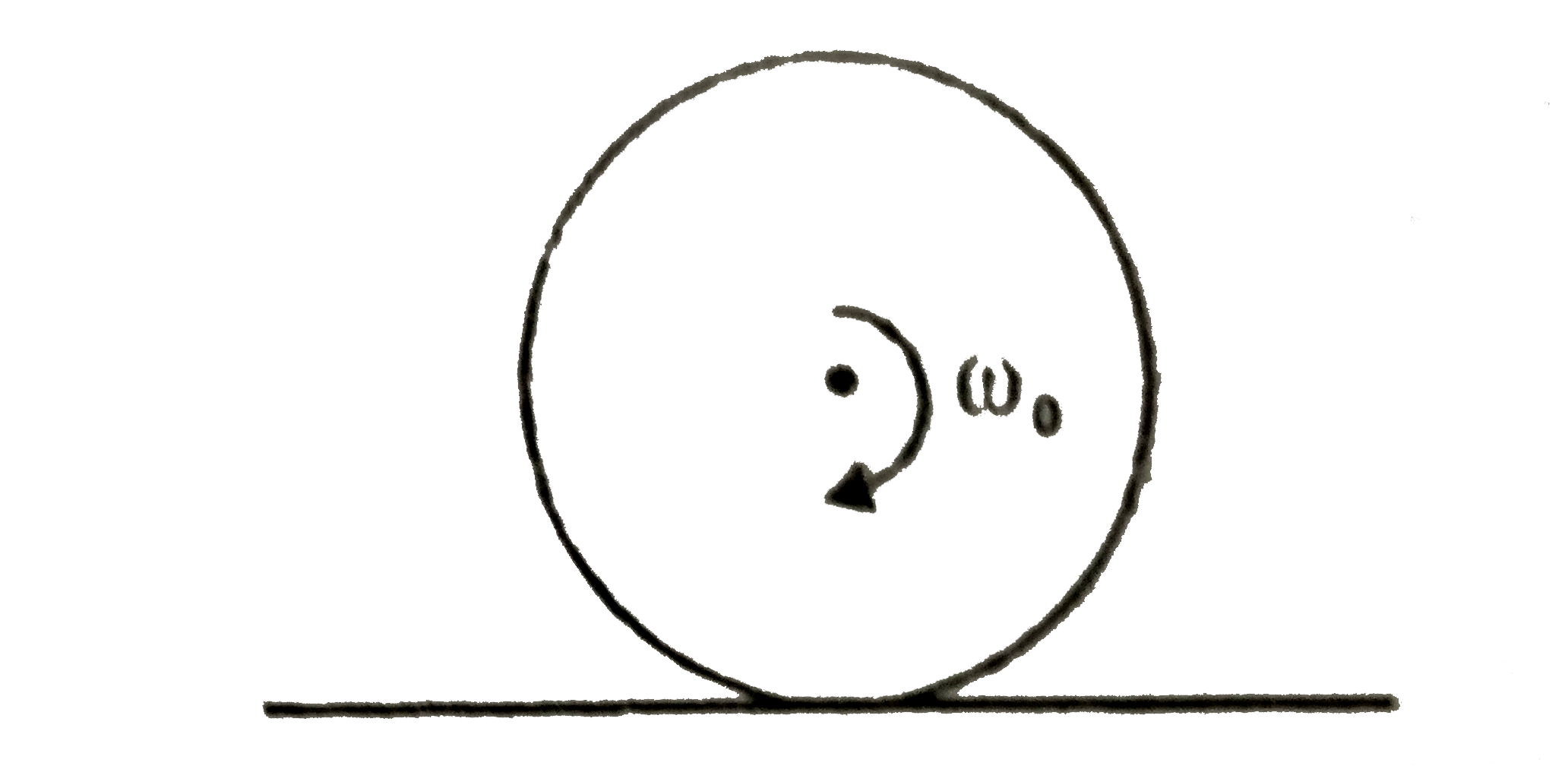A solid sphere of mass m and radiusr is given an initial angular velocity ω0 and a linear velocity v0=λrω0 from a point A on a rough horizontal surface .It is observed that the ball turns back and returens to the point A after some time if λ is less than a certain maximum value λ0 . Find λ0.

The correct Answer is:λ0=2/5
Ball will comes back to the initial position if its angular velocity is greater than zero is the same direction (in which it was released) at the moment its's linear velocity becomes zero. In his condition ball would returen back.

0=v0+(μg)t
t=v0μg (time when ball stop)
For rotation motion

τ=Iα
⇒α=τI=μgm×R¯¯¯¯¯¯¯¯¯¯¯¯25MR2=5μg2R2
using ωf=ω0−αt
ωf>0
⇒v0αR>5μg2R.v0μg for limiting condition
⇒λ0=25
Topper's Solved these Questions
- DAILY PRACTICE PROBLEMSBook:RESONANCEChapter:DAILY PRACTICE PROBLEMSExercise:dpp 67
Explore 2 Videos
- DAILY PRACTICE PROBLEMSBook:RESONANCEChapter:DAILY PRACTICE PROBLEMSExercise:dpp 68
Explore 7 Videos
- DAILY PRACTICE PROBLEMSBook:RESONANCEChapter:DAILY PRACTICE PROBLEMSExercise:DPP 65
Explore 5 Videos
- CURRENT ELECTRICITYBook:RESONANCEChapter:CURRENT ELECTRICITYExercise:Exercise
Explore 54 Videos
- ELASTICITY AND VISCOCITYBook:RESONANCEChapter:ELASTICITY AND VISCOCITYExercise:Advanced Level Problems
Explore 9 Videos
Similar Questions
A wheel of radius r starts rolling with an angular velocity ω and initial linear velocity V0 up an inclined smooth plane.The wheel will stop going up in time
View SolutionA solid sphere of mass M is placed on the top of a plank of the same mass, after giving an angular velocity ω0 at t=0. Find the velocity of the plank and the sphere when the sphere starts rolling:,

View Solution
Knowledge Check
A disc is given an angular velocity ω0 and a linear velocity v0 as shown in the figure. It is released on a rough horizontal surface of friction coefficient μ. Mark the correct statement (ω0=3v0/R)
 AThe frictional force will be μmg during the entire motion.BAfter some time the disc will start rolling without sliding along positive x-axis.CAfter some time the disc will start rolling without sliding along negative x-axis.DThe mechnical energy of the disc will remain conserved.
AThe frictional force will be μmg during the entire motion.BAfter some time the disc will start rolling without sliding along positive x-axis.CAfter some time the disc will start rolling without sliding along negative x-axis.DThe mechnical energy of the disc will remain conserved.A disc is given an initial angular velocity ω0 and placed on a rough horizontal surface as shown Fig. The quantities which will not depend on the coefficient of friction is/are
 Athe time until rolling beginsBthe displacement of the disc until rolling beginsCthe velocity when rolling beginsDthe work done by the force of friction
Athe time until rolling beginsBthe displacement of the disc until rolling beginsCthe velocity when rolling beginsDthe work done by the force of frictionA solid sphere of mass m and radius R rolls without slipping on a horizontal surface such that vc.m.=v0.
AThe kinetic energy of rotation is 15mv20.BThe total kinetic energy is 710mv20.CThe mechanical energy (assume the ground as reference) is mgR+710mv20.DAll options are correct.
_S01_038_Q01.png)
As per the shown figure the central solid cylinder starts with initial angular velocity ω0 Find the time after which the angular velocity becomes half.
View SolutionA uniform disc of mass m and radius R is given a velocity v0 and angular velocity ω0 as shown and released of a fixed horizontal surface. Only the x length of the surface is rough. Find the minimum value of x (in metres) so that disc starts pure rolling. Use ω20R272μg=1m

View SolutionA disc of mass m and radius R rotating with angular speed ω0 is placed on a rough surface (co-officient of friction =μ). Then

View SolutionA uniform solid sphere of mass m and radius 'R' is imparted an initial velocity v0 and angular ω0=2v0R and then placed on a rough inclined plane of inclination 'theta' and coefficient of friction μ=2tanθ as shown. The time after which the sphere will start rolling without slipping is

View SolutionA translational velocity v0 is imparted in a horizontal direction to a hoop of radius r placed on a rough horizontal surface. What is angular velocity of hoop after it stops slipping?
View Solution

